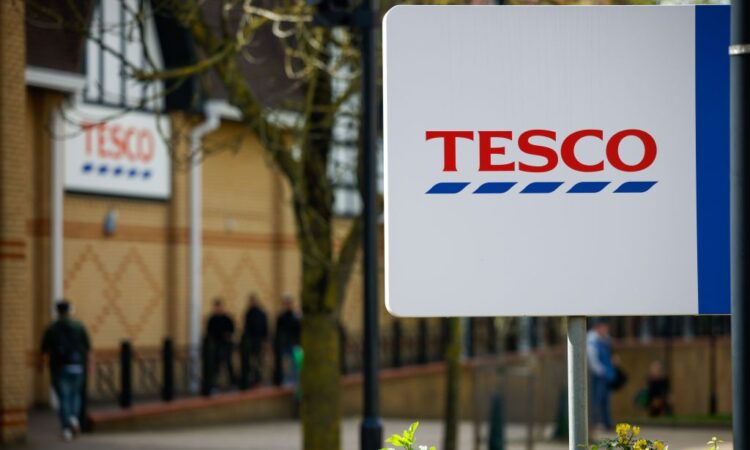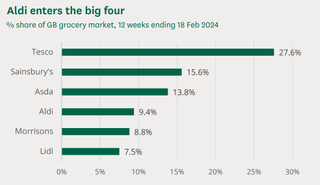
Supermarkets – we use them almost every day. Even when we’re not shopping in them, we are confronted by their image, logos and advertising as we walk down the street. Many of us even feel a sense of allegiance to a particular brand. Perhaps you are a Tesco shopper, a Sainsbury’s fan, or a Marks and Spencer loyalist. But should you take it a step further and invest in them?
Supermarkets have been in the news more than ever in the last couple of years, as food prices have soared thanks to persistent inflation. There have even been accusations of profiteering – a charge that food retailers have fiercely denied.
Given how much shoppers’ wallets are being squeezed, you would be forgiven for thinking that supermarkets are raking in the profits. But the reality is actually starkly different. The big UK supermarkets are operating in a fiercely competitive environment – one where they can quickly be priced out of the market if they don’t get their product prices right.
Sign up to Money Morning
Don’t miss the latest investment and personal finances news, market analysis, plus money-saving tips with our free twice-daily newsletter
Don’t miss the latest investment and personal finances news, market analysis, plus money-saving tips with our free twice-daily newsletter
And while the demand for food is inelastic, you only need to take a look at the supermarkets’ share prices to see that this doesn’t translate into a smooth ride for investors. In the post-2008 environment, investors have been taken on a bumpy ride thanks to changing consumer habits and the rise of big discounters like Lidl and Aldi.
With this in mind, do UK supermarkets offer the chance for investors to bag a bargain? Or, are you better off shopping around for opportunities in other sectors?
How has inflation impacted UK supermarkets?
Amid the cost-of-living crisis, supermarkets claim they have been doing everything they can to absorb price increases rather than passing them on to consumers. Shoppers might scoff. But the truth is that, by hiking prices out of step with competitors, supermarkets only hurt themselves.
The big UK supermarkets have faced tough competition from the discount retailers in recent years, and are under more pressure than ever to “price match” the likes of Lidl and Aldi. They have also faced close scrutiny from the government and the regulator.
Last summer, Tesco, Sainsbury’s, Asda and Morrisons all met with the government’s Business and Trade Committee. They told a very different story to the “greedflation” narrative being peddled in the press.
Tesco’s commercial director Gordon Gafa explained that profits for the group business were actually “down year on year”, with the supermarket having “sold more” but “made less”.
Rhian Bartlett, chief food commercial officer at Sainsbury’s, added that the supermarket was “inflating behind [its] input costs” and “wherever possible, behind the market”. She also pointed to a £560 million spending programme to keep prices low.
Supermarkets have since been vindicated by the competition watchdog, as attention shifts to their suppliers instead. Rather than being the beneficiaries of inflation, supermarkets have actually had their margins squeezed as prices rise.
Changing consumer habits have also created a more challenging environment for traditional supermarkets over the past decade.
The UK has seen a shift away from the big weekly shop, as households instead opt for shopping little and often. This change in behaviour means consumers are more likely to visit several stores over the course of a week, shopping around for their favourite products and the best deals.
The cost-of-living crisis has only accelerated this trend, as highlighted by a recent research report from the House of Commons Library.
The report writes that “46% of adults in Great Britain reported an increase in their cost of living in March 2024 compared to a month earlier”, with 89% pointing to increased food prices as the main reason for this. It adds that 49% were shopping around more as a result, while 38% were spending less on food shopping and essentials.
With this in mind, the big UK supermarkets are not as reliable an investment as you might think.
“Consumer staples companies, such as supermarkets, are traditionally seen as defensive parts of the markets, providing everyday items you still need to buy even in more challenging economic times”, says Jason Hollands, managing director at investment platform Bestinvest. However, he adds that traditional players have seen their margins decline as they have been forced to become more price competitive.
“Operating margins have thinned significantly with Tesco achieving c.2% in recent years, whereas a decade ago this was typically around the 5% mark”, Hollands explains. Given these challenges, he thinks it is difficult to get excited about the sector.
What is the future for the supermarkets?
Lidl and Aldi have cemented themselves as big players over the past decade – and they are clearly here to stay.
Aldi overtook Morrisons in terms of market share in September 2022, claiming the fourth spot behind Tesco, Sainsbury’s and Asda. When you look at the two German discounters together, they have a combined market share of 16.9% (second only to Tesco). That’s according to data from Kantar World Panel.

(Image credit: Kantar World Panel and the House of Commons Library.)
However, while the UK supermarket scene appears forever changed, it’s not all bad news for the traditional grocers.
On the one hand, “profits aren’t shooting the lights out”, acknowledges Guy Lawson-Johns, equity analyst at Hargreaves Lansdown. However, the flipside is that the cost-cutting programmes they have undergone in recent years have left them “in much better health than they were”.
He adds that strong cash flows, lower debt levels, and discounted valuations could mean that patient investors are rewarded. And while margins have been squeezed as supermarkets race to remain competitive, “incremental efficiency gains and improvements in sales mix should help [them] lift the ceiling on margins over time”.
Does the story differ from one supermarket to another?
If you are looking to invest in UK-listed supermarkets, the three you can consider are Tesco, Sainsbury’s and Marks and Spencer. Morrison’s was taken private in 2021 and Asda, Lidl and Aldi are also privately owned.
All three of the listed supermarkets are on a similar journey when it comes to things like cost-cutting and trying to grow market share. However, there are some important differences to keep an eye on too.
Hollands thinks that Tesco is the strongest pick of the group, pointing to its acquisition of the wholesale distributor Bookers, which “gives it a strong wholesale presence”. He adds that it has been growing its online offering too.
Tesco released its annual results earlier this week (10 April), revealing an increase in both sales and profits.
Alternatively, if investors are looking for a slightly different buy, then Marks and Spencer might be of interest. The stock fell out of favour with investors a few years ago, even dropping out of the FTSE 100 between 2019 and 2023. However, since then, the company’s management team has been on a mission to reshape the old M&S.
It is still early days, but there are tentative signs that this could be working. Marks and Spencer was the second best performer in the FTSE 100 last year, and the company managed to grow its overall market share in its food, clothing and homeware divisions.
What’s more, Marks and Spencer recently reinstated its dividend for the first time since the pandemic. This remains low at 1p per share – a measly yield of 0.39%. However, as Lawson-Johns points out, it “shows management are now more comfortable with the financial position they are in”.
Sainsbury’s currently offers the most attractive dividend yield of the three at 4.9%, according to data from Morningstar Direct. Tesco isn’t far behind at 4.07%.






